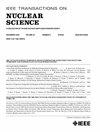Design of a Pipeline ADC for the MAPS of China Hyper-Nuclear Spectrometer
IF 1.9
3区 工程技术
Q3 ENGINEERING, ELECTRICAL & ELECTRONIC
引用次数: 0
Abstract
As the leading research platform of heavy-ion science in China, the physics and applications at the Heavy Ion Research Facility in Lanzhou (HIRFL) and the High-Intensity Heavy-Ion Accelerator Facility (HIAF) drive the development of new detector technology. The China Hyper-Nuclear Spectrometer (CHNS) is a planned all-silicon detector complex at HIAF that will study the hypernuclei with high statistics. A monolithic active pixel sensor (MAPS) is being designed in a 130-nm process for CHNS. This MAPS can measure the energy deposition, the hit position, and the arrival time of the particle hit. As the critical component of this MAPS, a 14-bit 40-Ms/s pipeline analog-to-digital converter (ADC) converts the analog signal from each region of pixels into digital data. It adopts the structure of sample-and-hold amplifier (SHA)-less and a first stage of 3.5-bit. In addition, bootstrapped switches, gain-boosting amplifiers, and the redundancy algorithm have been used in the design to improve conversion accuracy. This ADC has a power consumption of 138 mW and an area of求助全文
约1分钟内获得全文
求助全文
来源期刊

IEEE Transactions on Nuclear Science
工程技术-工程:电子与电气
CiteScore
3.70
自引率
27.80%
发文量
314
审稿时长
6.2 months
期刊介绍:
The IEEE Transactions on Nuclear Science is a publication of the IEEE Nuclear and Plasma Sciences Society. It is viewed as the primary source of technical information in many of the areas it covers. As judged by JCR impact factor, TNS consistently ranks in the top five journals in the category of Nuclear Science & Technology. It has one of the higher immediacy indices, indicating that the information it publishes is viewed as timely, and has a relatively long citation half-life, indicating that the published information also is viewed as valuable for a number of years.
The IEEE Transactions on Nuclear Science is published bimonthly. Its scope includes all aspects of the theory and application of nuclear science and engineering. It focuses on instrumentation for the detection and measurement of ionizing radiation; particle accelerators and their controls; nuclear medicine and its application; effects of radiation on materials, components, and systems; reactor instrumentation and controls; and measurement of radiation in space.
 求助内容:
求助内容: 应助结果提醒方式:
应助结果提醒方式:


